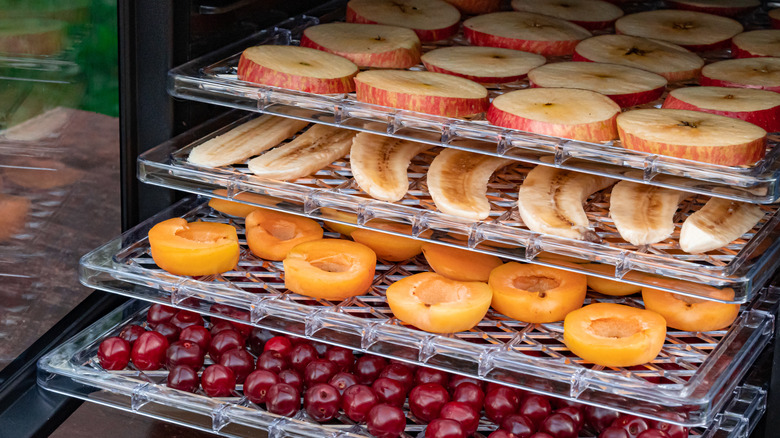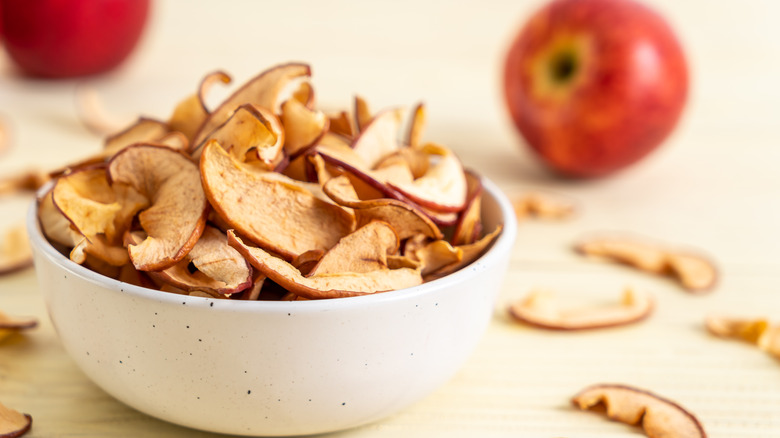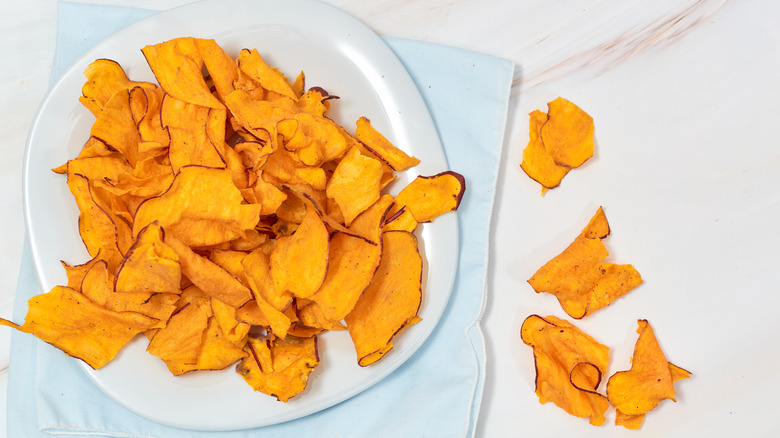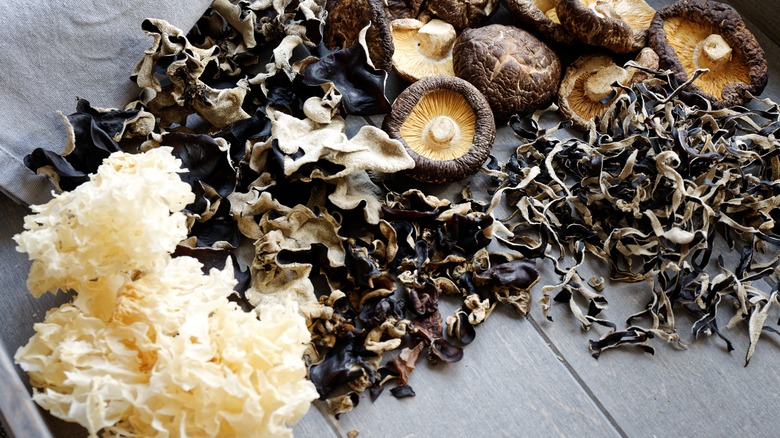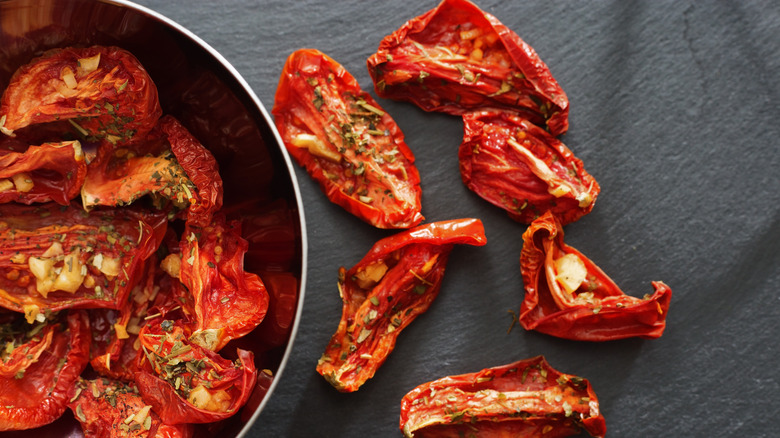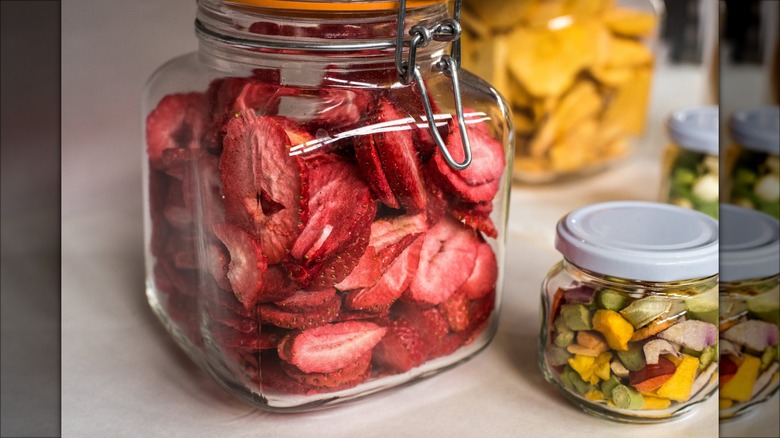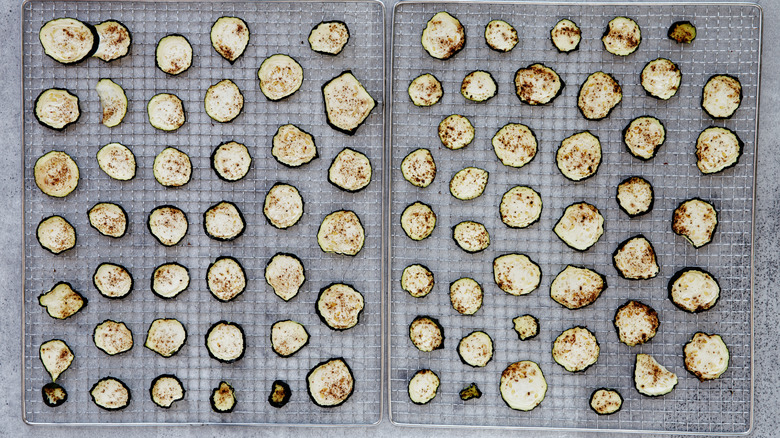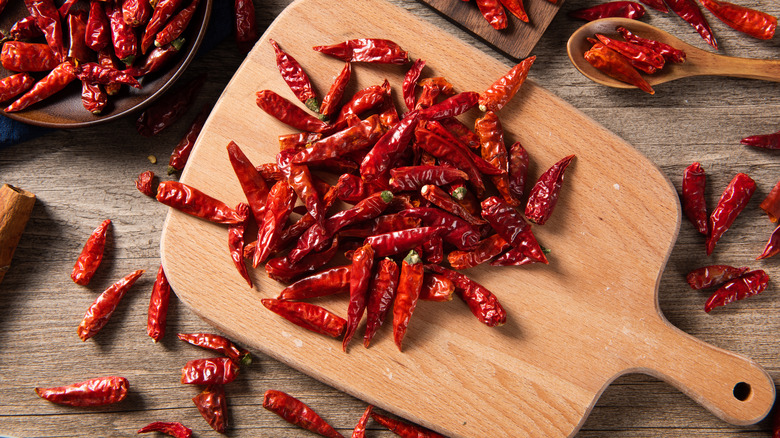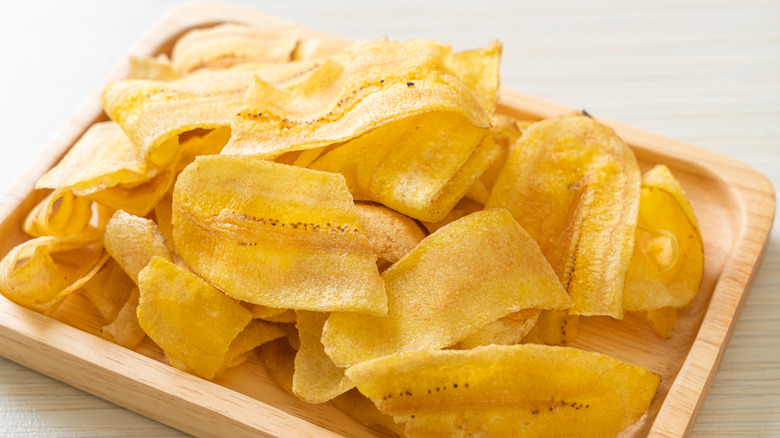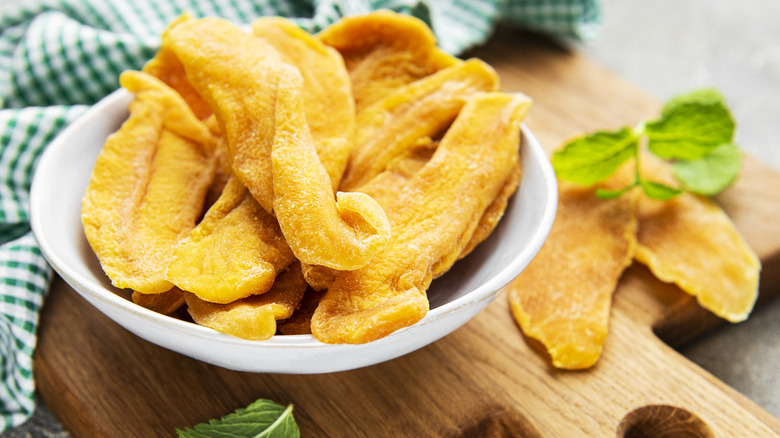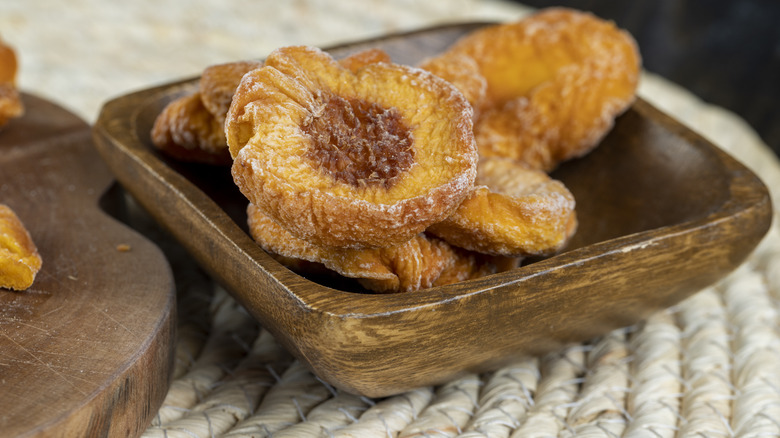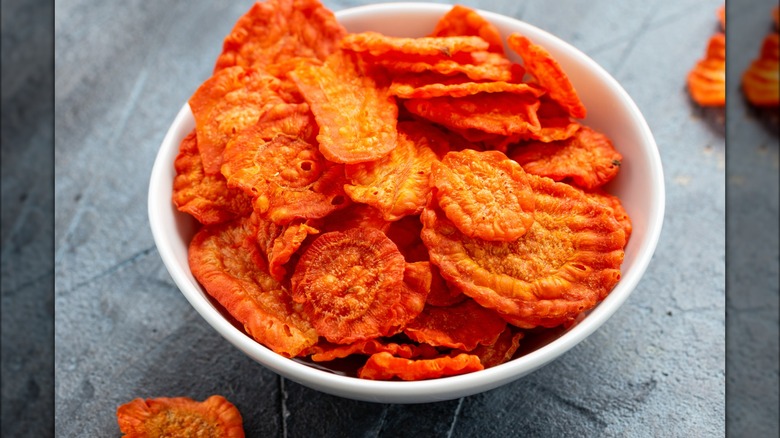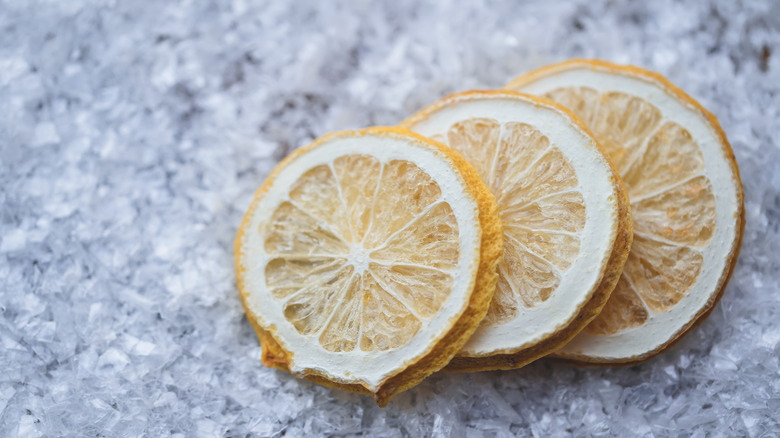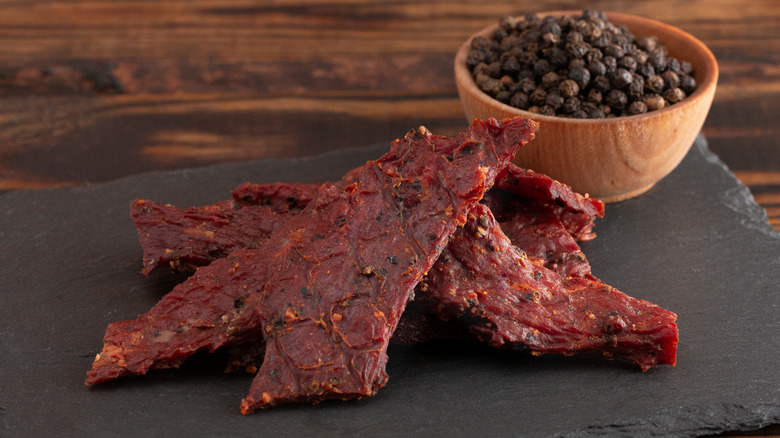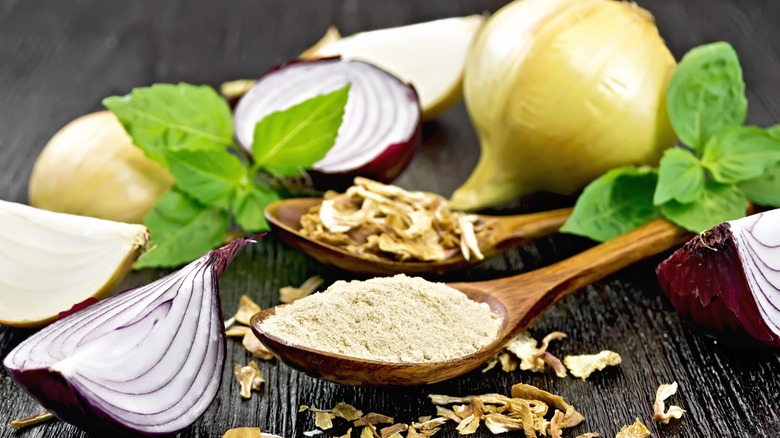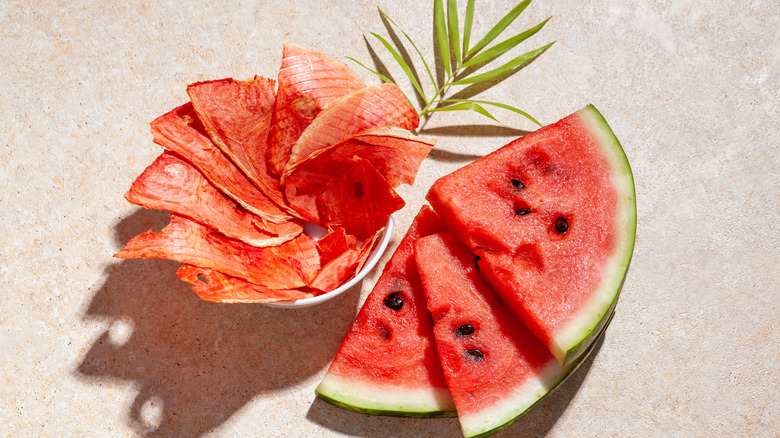15 Interesting Foods You Should Be Throwing In The Dehydrator
We may receive a commission on purchases made from links.
Have you been looking into dehydrating some of your own foods? There are actually several benefits to dehydrating various food items, including fruits, vegetables, and meats, but one of the biggest reasons to consider trying this is that is for preservation. The process of dehydration removes the moisture from your foods. With this lower water content, these items will last for much longer without the risk of spoiling. Many items will remain fresh and safe to use for several months when stored correctly (either in the pantry, fridge, or freezer depending on the food).
While you can dry fruit without a dehydrator, you'll find that the machine makes it much easier and foolproof. If you recently got a dehydrator, or are ready to dust off that purchase you made a while ago, then you're in the right place. We're going to explore some of the most interesting foods that you'll want to dehydrate. We'll also take a look at why they're so great dried and what you can do with them.
1. Apples
If you haven't tried dehydrating apples yet, there is no time like the present. There are several reasons you'll want to try dehydrated apples. First, they make a wonderful snack. You can adjust how long you leave them in your dehydrator based on whether you prefer a crispier or softer finished product. As with other foods, apples will keep for much longer when dehydrated. They can be stored in an airtight container in your pantry for about six months, or frozen for up to one year. You can dehydrate any of your favorite varieties of apples, including Granny Smith, Gala, Macintosh, and Red Delicious. They can take up to 12 hours in the dehydrator or as quick as 20 minutes, depending on the thickness of the cut, type of apple, and method you're using. The sweeter varieties won't maintain their shape as well as their tart counterparts, but they'll have a more concentrated sweetness to them.
Beyond snacking on this delicious treat plain, you can also add dehydrated apples to your morning oatmeal, use them to make a hearty trail mix, or dip them in peanut butter. The apples can also be rehydrated for use in muffin batters, apple pie, and more. Rehydrating them takes just a few minutes; all you need to do is steep them in a little hot water or apple juice, and they'll be ready to enjoy.
2. Sweet potatoes
Sweet potatoes are tasty, but they can take a long time to cook. Dehydrating sweet potatoes can really help speed up the cooking process. This can be a big time saver when you're trying to get a meal on the table. One of the other benefits of dehydrating sweet potatoes is that it makes them lighter and more compact. While the space they take up and their weight may not be of concern at home, if you like camping or backpacking, it can make a huge difference. Carrying a heavy sweet potato in your backpack isn't practical, but once they've lost their water content, they are much easier to bring on your next adventure.
Before dehydrating sweet potatoes, you'll want to wash and peel them. Then, cut them into the desired sizes, keeping in mind that thinner pieces will turn out the best when rehydrated. Blanch the sweet potatoes or bake them for about 15 to 20 minutes in the oven before dehydrating them to ensure they don't taste too raw once you're ready to eat them.
Once dehydrated, store your sweet potatoes in an airtight container for up to a year. For best results, keep the container in a dark pantry with a moisture-absorbing packet. Add your dehydrated sweet potatoes to soups, casseroles, and other moist recipes, or rehydrate them with some water to serve them on the side of a meal or make hash browns or mashed potatoes.
3. Mushrooms
Mushrooms may not be one of the first foods you think about putting in your dehydrator, but you'll be missing out if you don't give it a try. Dehydrated mushrooms are perfect for adding to your favorite soups, stews, and rice recipes. Fortunately, it is easy to rehydrate dried mushrooms. You can even shave the dried mushrooms to make an upscale topping for pasta dishes or crush them to a fine powder for cooking with. Dried mushrooms also last for about a year when stored properly. When you think about how quickly the fresh pack of mushrooms you purchased at the store can turn slimy, it's easy to see why this is such a huge benefit.
If you're ready to make dehydrated mushrooms, start by cleaning them off to remove the dirt. Instead of rinsing the tops with water as you likely do before cooking, try gently wiping them off using a damp towel. Too much water can make them become darker during the dehydration process. After wiping the mushrooms down, trim the stems and slice them. They'll take between 3 and 8 hours in the dehydrator, depending on their size, thickness, and the specific model you have. Remove them once brittle; you don't want them to still be flexible.
4. Tomatoes
If your garden is overrun with juicy red tomatoes, what better way to preserve them than through the dehydration process? Once dehydrated, you'll find that there are many ways you can use the tomatoes. Just a few ideas include adding them to pasta dishes, grinding them up to make tomato powder, tossing them with your salad, or just snacking on them plain. You'll find that the tomato flavor you know and love is more concentrated in these little bites of yumminess.
There are a few pointers to keep in mind before dehydrating tomatoes. First, you want to avoid putting them in the refrigerator before drying them out. Doing so can alter the flavor. It is also important to wash the tomatoes with water that is approximately 10 degrees warmer than they are. If you want to remove the skin before dehydrating — it isn't necessary — you can either chill the tomatoes in ice water to make it easier to remove or briefly dip them in a pot of boiling water. Slice the tomatoes up to 1⁄2-inch thick (or thinner if preferred) before putting them in your dehydrator. Once finished, store them in a cool and dark place or freezer in airtight bags for about 6 months.
5. Strawberries
Dehydrated strawberries can be a real treat. And, when you return from picking strawberries at a farm in the summer, you'll find that dehydrating them is a much quicker and easier method of preservation than trying to turn them into homemade jam. To dehydrate strawberries, start by washing them, towel-drying them to remove as much moisture as possible, and hulling them. Then, slice them and put them on the dehydrator tray. You should expect them to take about 5 or 6 hours to be ready.
Ripe strawberries — either that you picked yourself or that you purchased from a local farmer's market — will turn out better when dehydrated than those from the grocery store. Often the strawberries sold at grocery stores are picked too early to prevent them from spoiling during transit, so their flavor just doesn't compare to that of fresh-picked ones. You'll also want to avoid using strawberries that have been frozen before. They'll be holding too much moisture to dry properly and won't have the right texture.
6. Zucchini
Zucchini is another vegetable (though, technically, a fruit) that can take over your summer garden. You may find yourself with so many zucchinis that you won't know what to do with them. Well, if you're ever in this situation (or simply love zucchini and want to try it in different ways), consider pulling out your dehydrator. When you dehydrate zucchini, it can last for nearly a year, significantly longer than when fresh. One of the great things about dehydrated zucchini is that it is so versatile and easy to incorporate into other recipes. The zucchini rehydrates beautifully when added to soups and stews, sauces, or boiling water when cooking pasta. You can even eat the dehydrated zucchini plain or with a little salt or seasonings. The crunch may have you convinced that you're eating a potato chip.
The best zucchinis to dehydrate will be those that are smaller in size. Once they get too big, they'll have too many seeds that you'll need to remove before dehydrating them. After cleaning the zucchini, slice them evenly. If you're making chips, thinner, ⅛-inch slices are ideal. If you'll be adding the dehydrated zucchini to other recipes, then aim for slightly thicker, 1⁄4-inch slices. Alternatively, you can also shred the zucchini before dehydrating it. The sliced zucchini should take between 6 and 12 hours in the dehydrator.
7. Peppers
If you are a fan of hot and spicy foods, then drying peppers in your dehydrator is something you'll definitely want to try. When they are dehydrated, the heat intensifies. Add the dehydrated hot peppers to chili, soups, casseroles, or any other dishes that you are looking to give an extra kick. Jalapeños and other hot peppers aren't the only varieties you can dehydrate. You can also stick green, red, and yellow bell peppers in the dehydrator to enjoy their sweeter and not-as-spicy flavor.
There is one very important thing to take note of before dehydrating any type of hot peppers. These varieties include capsaicin, the compound responsible for making them so spicy. Capsaicin can irritate your eyes, nose, throat, or skin. For this reason, it is always a good idea to wear gloves when dehydrating peppers. Once you have the peppers prepped and in the dehydrator, be sure to wash your hands.
8. Bananas
There are several ways to use dehydrated bananas. They offer that classic banana flavor that you know and love, while also being slightly sweeter than you might expect. Because all of the moisture has been removed from bananas are also a bit chewy, an interesting contrast from the soft and squishy texture of a raw banana. You'll find that the taste and texture combination makes them perfect for snacking on right out of the jar or for adding to cereals or trail mixes. You can also use them to top a yogurt parfait or smoothie.
If you're ready to try using your dehydrator for bananas, you might want to treat the slices with a little lemon juice to keep them from turning brown as they dry. Bananas won't take as long as some other fruits and should be ready in 3 to 6 hours. For crispier dehydrated bananas, it is recommended to start with firmer, less-ripe bananas. If they have ripened (or especially over-ripened), the resulting texture will be more sticky than crunchy.
9. Mangoes
Dehydrated mangos have a deliciously sweet flavor. If you love fresh mangoes, you'll find that the dehydrated version has a more concentrated flavor, making it a healthier alternative to other foods when you're craving something a little sweet. Better yet, mangoes are very easy to dehydrate. They require minimal prep work; just peel them, cut them into slices, and arrange them on the dehydrator trays. Make sure you cut thin slices (about ¼-inch or so), as they will take longer to dry out if they are too thick.
After you've dehydrated the mango slices, there are so many different ways you'll be able to use them. As mentioned above, they'll taste delicious when eaten by themselves, but you can also try adding them to trail mix, chopping them up to add to muffin or scone batter, dipping them in chocolate, using them to make cookies, or tossing them into the slow cooker when making pulled pork.
10. Peaches
Peaches are a scrumptious summer fruit. But, if you love peaches, why limit yourself to enjoying them during the summer when they're in season? Stock up on fresh peaches from your local farmers market so you can dehydrate them for year-round enjoyment. You'll find that dehydrated peaches taste quite similar to their fresh counterparts and that they can make a tasty snack. You can also add your dehydrated peaches to oatmeal, yogurt, muffin recipes, and so much more. Alternatively, you can even rehydrate them to make recipes such as peach pie or peach cobbler.
When dehydrating peaches, be sure to choose ones that are ripe, with a little give and a fragrant scent. It is also important to avoid using any bruised peaches or those that are overripe, as they won't turn out as desired. After selecting the perfect peaches for dehydrating, you can either peel the skin or leave it on. Then, cut the peaches into thin slices and remove the pit. A thickness of 1⁄4-inch is ideal if you want to make peach chips, while closer to 1⁄2-inch will be better for rehydrating in the future or if you want the finished results to have a chewier texture. Expect your peaches to take between 8 and 12 hours to dehydrate and be ready to enjoy and store for the future.
11. Carrots
If you haven't tried dehydrating carrots yet, there is no time like the present. You'll find that when you dehydrate carrots, they will taste sweet and still have a classic and distinct orange color. Dehydrating a batch of carrots can cut your prep time down any time you're making a soup or stew that you need them for. As long as the dish you're making has some liquid, the carrots will rehydrate beautifully within a few minutes, preventing you from having to slice them for each recipe you need them for. You can also snack on dehydrated carrots as carrot chips or throw them into your backpack for your next camping or hiking adventure.
Preparing carrots for the dehydrator won't look much different than preparing them to add to a favorite recipe. Once you've cleaned the carrots and your work area, cut off the tops and peel the skin. Rinse them one more time to get rid of any dirty residue that remains on their surface. Then, you can either shred or slice the carrots depending on how you think you may use them once they're dehydrated. If you want your carrots to be a little softer when dehydrated, blanch them in boiling water for about 2 minutes before rinsing them with cold water and patting them dry. The carrots should take between 8 and 12 hours in the dehydrator.
12. Lemon
Dehydrated lemon? Yep, this is another interesting fruit that you're going to want to try to dehydrate. There are so many different ways you can use dehydrated lemon that you'll be sad you haven't tried making them before. Try grinding them into a powder to make homemade lemon pepper, adding them to your morning or evening cup of tea, adding them to dishes with fish, and so much more. You can even grind up the dehydrated lemon and use it to make incredible fried chicken.
If you're ready to try dehydrating lemons, just be prepared. They'll take a lot longer than many other fruits and vegetables due to their higher moisture content. Expect them to take at least 18 hours, but possibly 36 or more to be dry and ready. Make sure to store the dehydrated lemons in an airtight container, ideally in a cool and dark location, to help them last for as long as possible.
13. Steak
Want to try to make your own beef jerky? If so, you'll want to choose the right cut of steak. One of the best cuts of meat to use is top round steak, sometimes labeled as London Broil. Not only is it a leaner cut that will be easier to dehydrate than fattier options, but it is also relatively inexpensive. This means you can make tasty and long-lasting homemade jerky without spending a fortune.
Before you can dehydrate the steak, you'll need to prepare it. This will involve slicing it into thin, ¼-inch strips and then letting it marinate for at least 6 hours, but up to 12 hours, in the fridge. You can customize the marinade based on your tastes, but consider adding a meat tenderizer to it to help soften the tissue to make the finished product more enjoyable. After marinating, cook the slices to kill any bacteria that may be present. The internal temperature should reach at least 160 degrees Fahrenheit before proceeding. Then, dehydrate the beef in your machine until there is no more moisture present (typically 4 to 6 hours).
14. Onions
You'll love all the uses you'll discover for dehydrated onions. Grind the dried onions to make your own onion powder, slice them very thin for dried onion flakes or minced onions, or make your own herb or dip mixes using other seasonings from your pantry (or other herbs that you've dehydrated yourself). Having dried onions in your pantry can be very convenient when you're making soups, casseroles, and other recipes. You don't need to pull out the cutting board and a knife or even worry about whether you have onions in the house. Just add the dried onions to your dishes and they will rehydrate in the liquid. If there isn't enough liquid in the recipe you're preparing, soak the onions in warm water (one part onion to two parts warm water) for 15 to 25 minutes to rehydrate them.
When preparing your onions for the dehydrator, slice them evenly so that they will all take the same amount of time to dry and be ready for use or storage. If you'll be preparing a large batch of onions, you might want to take a few extra precautions. This can be especially true if you're more sensitive and prone to crying from the enzymes in the onions that convert into gasses when they're cut. Consider wearing goggles and refrigerating the onions before cutting them. Using a sharp knife is also important as it will cleanly slice the onions and prevent as much gas from escaping.
15. Watermelon
Watermelon is another fruit that many of us can't get enough of during the summer months. It is always sad to say farewell to this juicy fruit once it is no longer growing on the fields at your local farms. And, while you can often find watermelon during the colder months at the grocery store, it is never the same as buying a fresh, in-season one. Dehydrating watermelon can help you extend its shelf life to enjoy during the cooler months as you eagerly await the next summer's crop. Once dehydrated, watermelon has a nice and crunchy texture combined with its signature sweet flavor that makes it taste just like candy. You may hear dehydrated watermelon referred to as candy, jerky, chips, or taffy. Whatever you call it, it's delicious.
Start with a sweet, ripe watermelon for the tastiest results, then cit it into thin slices. You'll want to aim for a thickness between ¼-inch and ½-inch for more uses. Place the slices on the tray and then place them in the dehydrator. Depending on the thickness and moisture content, expect it to take between 8 and 18 hours to dry.
